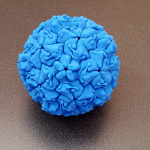3D Printing
The CRC group currently manages three Fused Deposition Modeling (FDM) 3D printers — FlashForge Guider II(S). The printers are located in the VizLab (Coram 102). They are available for academic projects only. A training session on proper use is a prerequisite to printing. Interested users must contact the VizLab and a CRC team member will be in touch.
Projects
Our 3D printers have been used to support multiple faculty projects, ranging from the creation of custom set pieces for the theater department to printing classroom models for the biology and chemistry departments, such as the Rhinovirus print shown here (created for Bio 314-Virology). We also used 3D printing to help with the local PPE shortage in early 2020.
Software
3D printing generally requires two different kinds of software. The first, CAD (computer-aided design) or 3D modeling software, is used to create the computer model that will be sent to the printer. There are many different software packages that can be used for this, but some of the most popular are AutoCAD (or Fusion360– both of which are free for students and faculty), Rhino, and Blender (free & open source). If you are new to 3D modeling, Tinkercad is a great place to start. There are also many specialized modeling programs available, such as Chimera from UCSF, which is used to create molecular models.
It is also sometimes possible to 3D scan an object you would like to print, or to simply download a 3D model that has been created for you. There are an increasing number of model repositories online, such as MorphoSource, PDB-101, the Protein Data Bank, or Thingiverse.
The second type of software is responsible for taking the 3D model and preparing it so that it can be printed. The Vizlab has Simplify3D installed and licensed on a number of machines for this purpose. The very specific settings for each printer are preloaded and modified according to each print’s varying needs. This need is usually based on filament changes- while PLA is the stock choice for these printers, we also have some experimental materials like flexible, metal & wood infused plastics, and PETG.
Learn more
If you’d like to learn some of the fundamental concepts and history of 3D printing, see this handy guide by 3DInsider.
Hubs.com also has some nice guides for FDM printing knowledge.
Support Staff
Branden Rush
Coram 104
207-753-6980
brush@bates.edu
Dale Rothenberg
Coram 105
207-786-6387
drothenberg@bates.edu
